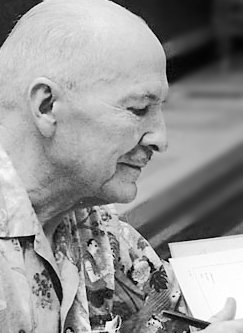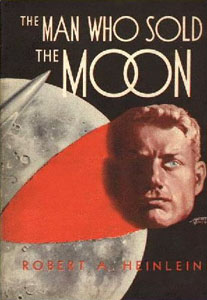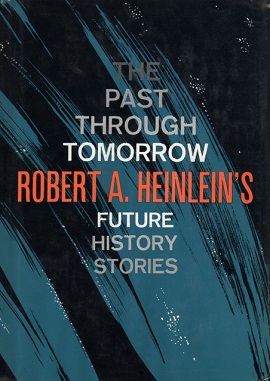Plot
The story centers around D. D. Harriman, the lead character of The Man Who Sold the Moon. Harriman, a tycoon and latter-day robber baron, had always dreamed of going to the Moon, and had spent much of his career and resources making space flight a practical commercial enterprise. Unfortunately, his business partners prevented him from taking the early flights because they could not risk the public face of their company. Now an old man, Harriman has still not been to the Moon, a fact that frustrates him, since he lives in a world where space travel is so commonplace that carnivals have their own barnstorming spacecraft. Although no longer bound by his contractual obligations, he is now too old to pass the medical examination needed for space travel.
Very wealthy, Harriman bribes two spacemen to help him get to the Moon after encountering them at a funfair in Butler, a small town outside Kansas City, Missouri (and Heinlein's birthplace), where they sell rides on their old, somewhat run-down ship.
The three of them fight many obstacles, including Harriman's heirs, who want him declared mentally incompetent or senile before he can spend their inheritance. In the end, Harriman finally makes it to the Moon, only to die on the surface soon after landing, content at finally having reached his goal. His body is left there, with his epitaph scrawled on the tag from an oxygen bottle. It is Robert Louis Stevenson's:
Under the wide and starry sky
Dig the grave and let me lie:
Glad did I live and gladly die,
And I laid me down with a will!
This be the verse you grave for me:
Here he lies where he longed to be;
Home is the sailor, home from sea,
And the hunter home from the hill.
—
"Requiem" by Robert Louis Stevenson inscribed on his own headstone in Samoa

John Wood Campbell Jr. was an American science fiction writer and editor. He was editor of Astounding Science Fiction from late 1937 until his death and was part of the Golden Age of Science Fiction. Campbell wrote super-science space opera under his own name and stories under his primary pseudonym, Don A. Stuart. Campbell also used the pen names Karl Van Kampen and Arthur McCann. His novella Who Goes There? was adapted as the films The Thing from Another World (1951), The Thing (1982), and The Thing (2011).

Robert Anson Heinlein was an American science fiction author, aeronautical engineer, and naval officer. Sometimes called the "dean of science fiction writers", he was among the first to emphasize scientific accuracy in his fiction, and was thus a pioneer of the subgenre of hard science fiction. His published works, both fiction and non-fiction, express admiration for competence and emphasize the value of critical thinking. His plots often posed provocative situations which challenged conventional social mores. His work continues to have an influence on the science-fiction genre, and on modern culture more generally.

Robert Louis Stevenson was a Scottish novelist, essayist, poet and travel writer. He is best known for works such as Treasure Island, Strange Case of Dr Jekyll and Mr Hyde, Kidnapped and A Child's Garden of Verses.

To Sail Beyond the Sunset is a science fiction novel by American writer Robert A. Heinlein, published in 1987. It was the last novel published before his death in 1988. The title is taken from the poem "Ulysses", by Alfred Tennyson. The stanza of which it is a part, quoted by a character in the novel, is as follows:

The Moon Is a Harsh Mistress is a 1966 science fiction novel by American writer Robert A. Heinlein about a lunar colony's revolt against absentee rule from Earth. The novel illustrates and discusses libertarian ideals. It is respected for its credible presentation of a comprehensively imagined future human society on both the Earth and the Moon.

Methuselah's Children is a science fiction novel by American writer Robert A. Heinlein. Originally serialized in Astounding Science Fiction in the July, August, and September 1941 issues, it was expanded into a full-length novel in 1958. The novel is part of Heinlein's Future History series of stories. It introduces the Howard families, a fictional group of people who achieved long lifespans through selective breeding.
" '—All You Zombies—' " is a science fiction short story by American writer Robert A. Heinlein. It was written in one day, July 11, 1958, and first published in the March 1959 issue of The Magazine of Fantasy & Science Fiction after being rejected by Playboy.
"Blowups Happen" is a 1940 science fiction short story by American writer Robert A. Heinlein. It is one of two stories in which Heinlein, using only public knowledge of nuclear fission, anticipated the actual development of nuclear technology a few years later. The other story is "Solution Unsatisfactory", which is concerned with a nuclear weapon, although it is only a radiological "dirty bomb", not a nuclear explosive device.
"The Green Hills of Earth" is a science fiction short story by American writer Robert A. Heinlein. One of his Future History stories, the short story originally appeared in The Saturday Evening Post, and it was collected in The Green Hills of Earth. Heinlein selected the story for inclusion in the 1949 anthology My Best Science Fiction Story. "The Green Hills of Earth" is also the title of a song mentioned in several of Heinlein's novels.

"The Man Who Sold the Moon" is a science fiction novella by American author Robert A. Heinlein, written in 1949 and published in 1950. A part of his Future History and prequel to "Requiem", it covers events around a fictional first Moon landing in 1978 and the schemes of Delos D. Harriman, a businessman who is determined to personally reach and control the Moon.

The Man Who Sold the Moon is the title of a 1950 collection of science fiction short stories by American writer Robert A. Heinlein.

The Past Through Tomorrow is a collection of science fiction stories by American writer Robert A. Heinlein, first published in 1967, all part of his Future History.

Destination Moon is a 1950 American Technicolor science fiction film, independently produced by George Pal and directed by Irving Pichel, that stars John Archer, Warner Anderson, Tom Powers, and Dick Wesson. The film was distributed in the United States and the United Kingdom by Eagle-Lion Classics.

Requiem: New Collected Works by Robert A. Heinlein and Tributes to the Grand Master is a retrospective on Robert A. Heinlein (1907–1988), after his death, edited by Yoji Kondo.
The science fiction writer Robert A. Heinlein (1907–1988) was productive during a writing career that spanned the last 49 years of his life; the Robert A. Heinlein bibliography includes 32 novels, 59 short stories and 16 collections published during his life. Four films, two TV series, several episodes of a radio series, at least two songs and a board game derive more or less directly from his work. He wrote a screenplay for one of the films. Heinlein edited an anthology of other writers' science fiction short stories.
"Destination Moon" is a novella by science fiction author Robert A. Heinlein, first published in the September 1950 issue of Short Stories magazine; it is an adaptation of Heinlein's own screenplay for the 1950 feature film Destination Moon. It was reprinted in the posthumous collection Requiem.
Delos David Harriman, known as D.D. Harriman, is a character in the fiction of science fiction author Robert A. Heinlein. He is an entrepreneurial businessman who masterminded the first landing on the Moon as a private business venture. His story is part of Heinlein's Future History.
The Heinlein juveniles are the science-fiction novels written by Robert A. Heinlein for Scribner's young-adult line. Each features "a young male protagonist entering the adult world of conflict, decisions, and responsibilities." Together, they tell a loosely connected story of space exploration. Scribner's published the first 12 between 1947 and 1958, but rejected the 13th, Starship Troopers. That one was instead published by Putnam. A 14th novel, Podkayne of Mars, is sometimes listed as a "Heinlein juvenile", although Heinlein himself did not consider it to be one.

A Robert Heinlein Omnibus was a second collection of Robert A Heinlein's stories to use the term "omnibus" the first being The Robert Heinlein Omnibus (1958), published in 1966. Containing fifteen of Heinlein's short stories and novellas, this second "Omnibus" represents a short chronological period, 1940 to 1950, of Heinlein's writings.











